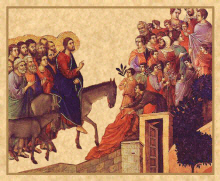|
†
Sacred Liturgy - Holy
Week 2010 |
|
Palm Sunday /
passion sunday

Benedictus qui venit in nomine Domini. Hosanna in
excelcis!
Blessed is He that cometh in the name of the Lord. Hosanna
in the highest!
Holy Week, the most solemn and intense period of worship in
the Christian faith, begins with Passion Sunday, the Sunday
before Easter. In spite of the spiritual gravity of Holy
Week, it begins with joy; for on this Sunday, the Church
celebrates Jesus' triumphal entry into Jerusalem which
foretells the victory of His Resurrection and His return to
earth in glory; and with the first reading of the Passion in
the liturgies of Holy Week, the Church begins her
commemorative pilgrimage with her Lord on His way to
Calvary.
Liturgical commemoration of the Passion actually begins
during the fifth week of Lent, when Masses are focused on
the power of the Cross and the Kingship of Christ. Until the
liturgical reforms just before the Second Vatican Council
restored important liturgical elements of the early Church
which had gradually disappeared (the Easter Vigil, for
example), the Fifth Sunday of Lent was called Passion
Sunday, and the Sunday beginning Holy Week was called Palm
Sunday. Earliest accounts describing the beginning of Holy
Week speak of Passion Sunday.
Blessed Palms
The blessing and distribution of palms takes place on
Passion Sunday, and altar decorations are palm branches
rather than flowers. The palms are solemnly blessed by the
priest, and each worshipper holds the blessed palm during
the singing of the ancient hymn, Gloria Laus ("All Glory,
Laud and Honor") and during reading of the Passion.
These solemnly blessed palms are sacramentals, or signs of
Christ's grace which help Christians in the practice of the
faith, and, as they are associated with Christ's triumph,
the palms symbolize victory over spiritual danger and death.
For this reason, palms are associated with martyrdom, and
often appear in paintings and sculpture of those who were
martyred for the faith. This also explains the old custom of
burning a palm in the stove in time of danger (from a
threatening storm, for example).
As the blessed palms are sacramentals, then, Catholics keep
them in their homes, customarily placing them behind the
crucifix. The ashes used on Ash Wednesday come from the
burning of blessed palms.
This Sunday was also sometimes called the Pasch of Flowers
in European countries, because throughout the Middle Ages
flowers were blessed on this day along with palms and olive
branches. (The State of Florida is so named because Ponce de
Leon landed there on Pasqua Florida Sunday.) The words "pasch"
and "paschal" come from the Hebrew word "pesach'" meaning
"passage" or "passover."
The Passion Sunday liturgy, incorporating both the blessing
of the palms and commemoration of Jesus' entry into
Jerusalem to the joyous Hosannas of the people, and the
reading of the Passion Gospel, combines two contrasting
elements .The two parts are linked by the traditional
procession which follows the blessing and distribution of
the palms and which leads into the Sacrifice of the Mass;
hence symbolically reproducing the historical event of Our
Lord's royal entry into Jerusalem which signifies the actual
meeting of the Church with Christ; moreover, His entry
foretells the entry of the faithful into the eternal
Jerusalem, the Kingdom of Heaven.
Palm Procession
According to the account of a fifth-century Spanish pilgrim
to the Holy Land, Passion Sunday Mass was celebrated in
Jerusalem at the Church of the Holy Sepulchre. After this
the people were invited to meet again in the afternoon at
the Mount of Olives, in the Church of Eleona (the grotto of
the Our Father). They then proceeded to the Church of the
Ascension for a service consisting of hymns and antiphons,
readings and prayers, where at five o'clock in the afternoon
the Gospel of the palms was read and the procession set out
for the city. The people responded to the antiphons with the
acclamation, "Blessed is He who comes in the name of the
Lord," as we say even today.
All these pilgrims carried palms, and with their little
children in their arms they escorted the bishop (who
represented the Savior) to the Church of the Resurrection
where the processsion ended with Vespers (evening prayer).
This palm procession was introduced in the West first in
France and then in Italy. In the Middle Ages the custom
began of carving a wooden statue of Christ seated on a
donkey which was then placed on a cart, the center of the
procession. These statues were called Palm Donkeys or
Palmesels, and some are preserved in museums.
In medieval Rome the papal procession set out from the papal
residence at the Lateran, then the official headquarters of
the Popes as the Vatican is now. The palms were blessed by a
cardinal and some were distributed by acolytes at the
ancient Church of St. Sylvester nearby. The Pope
alsodistributed them himself in the Hall of Leo IV at the
Lateran.
Return to the main page for Holy Week»»
This page is the work of the Servants of the Pierced Hearts of Jesus and
Mary
Copyright © 2006-2010 SCTJM
|